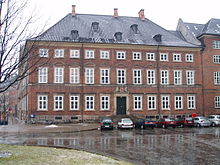German law firm (Copenhagen)
The German firm ( Danish Tyske Kancelli , from 1806 Schleswig-Holstein Law Firm , 1816-1849 Schleswig-Holstein Lauenburg firm ) was from 17 to 19 century, for in personal union by the Danish king ruled duchies of Schleswig and Holstein competent administrative authority Based in Copenhagen .
The term German office is explained by the German administrative language used by the office . Schleswig itself was a Danish fiefdom , while Holstein was a German Reichslehen and later a member state of the German Confederation .
History and skills
The German Chancellery was set up in 1523 by King Friedrich I to exercise rule in the counties and duchies of the entire state. The area of responsibility comprised primarily the legal, school and church system. Until 1770, the German law firm also performed foreign policy tasks (with the exception of the Nordic countries). It had a corresponding department for external ( Tyske Kancellis udenrigske afdeling ) and internal affairs ( Tyske Kancellis indenrigske afdeling ). The administration of the central parts of the country ( Jutland , Funen , Zealand and until 1645 Halland and until 1656 Schonen and Blekinge ) as well as Norway and the North Atlantic possessions ( Iceland , Faroe Islands and Greenland ) was carried out by the Danish office in Danish. Both authorities had their origins in the ducal chancellery of Friedrich I at Gottorf Castle and mark the establishment of a central state administrative organization in the early modern period. The German chancellery was initially mainly occupied by representatives of the Holstein nobility, files and correspondence were initially conducted in Low German and from around 1540 in New High German .
After the introduction of absolutism in 1660, the German Chancellery was organized as a college and as such was the central supreme authority for the performance of state administrative affairs in Schleswig - with the exception of the royal enclaves , which were subordinate to the Danish chancellery - and in the royal part of Holstein. After the Gottorf share in the Duchy of Holstein was abolished , the German Chancellery administered the entire Duchies of Schleswig and Holstein and, from 1815, Lauenburg as well . From 1667 to 1773 she was also responsible for the counties of Oldenburg and Delmenhorst . Associated with her were the royal chancellery in Glückstadt and, from 1713, the Gottorf High Court in Schleswig. The office, whose official language always remained German, played an important role in shaping the entire Danish state .
The office was closed on September 2, 1849 during the Schleswig-Holstein War (1848–1851) .
The German administrative language used by the German chancellery in the duchies was one of several factors that caused the language change in southern Schleswig from Danish to German.
Lore
The files relating to foreign affairs as well as Oldenburg and Delmenhorst are kept in the Reichsarchiv Copenhagen . The rest of the tradition is divided between the Reichsarchiv and the Landesarchiv Schleswig-Holstein . From the period up to 1730 the greater part is in the Reichsarchiv, from the period after 1730 the greater part is in the state archive in Schleswig .
See also
literature
- Heinz Lehmann: The German law firm in Copenhagen as a champion for absolutism in Denmark and as an administrative branch within the Danish administrative system until 1676. 1936
Web links
- Stock Tyske kancelli ( Memento of 5 February 2008 at the Internet Archive ) in the Danish National Archives
- Stock 65: German law firm in Copenhagen in the Schleswig-Holstein State Archives
Individual evidence
- ↑ Jann Markus Witt: Schleswig-Holstein from the origins to the present . Ed .: Jann Markus Witt, Heiko Vosgerau. Convent, Hamburg 2002, ISBN 3-934613-39-X , Peace, Prosperity and Reforms - The Duchies in the Danish State, p. 222-223 .
- ^ Heiko Wartenberg: Archive Guide to the History of Pomerania up to 1945 . Oldenbourg, Munich 2008, ISBN 978-3-486-58540-7 , pp. 219 .
- ^ Robert Bohn: Danish history . Beck, Munich 2001, p. 57 .
- ↑ Danske Kancelli. Aarhus Universitet, Institut for Historie og Områdestudier, accessed on May 28, 2012 .
- ↑ Tyske Kancelli. Grænseforeningen, accessed May 28, 2012 .
- ^ Manfred Hinrichsen: The development of language conditions in the Schleswig region . Wachholtz, Neumünster 1984, ISBN 3-529-04356-7 , pp. 110 .
Coordinates: 55 ° 40 ′ 32 " N , 12 ° 34 ′ 56.4" E
